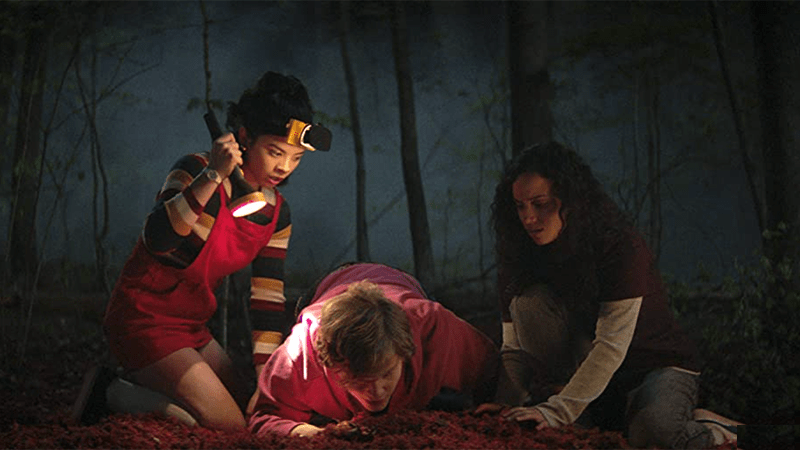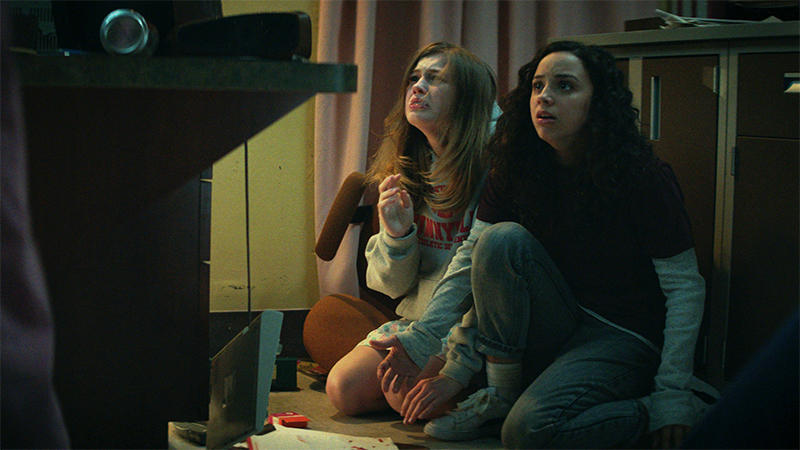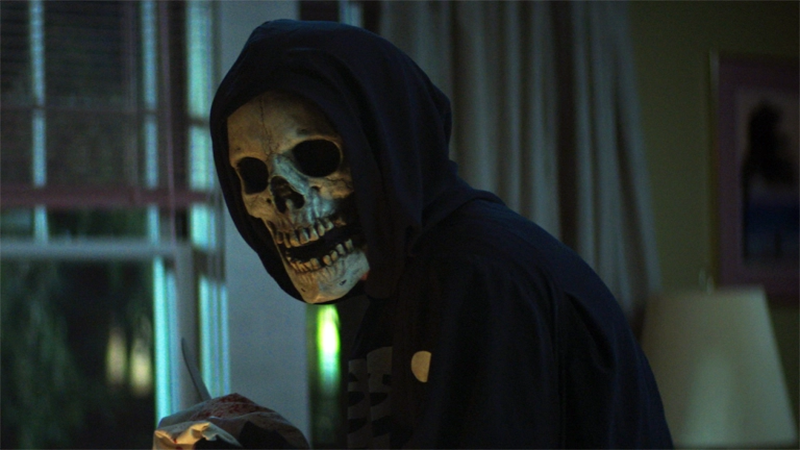There are significant spoilers for the Fear Street: 1994 gay characters below!
Read at your own risk! If you’re here because you simply want to know if you should/shouldn’t watch this movie and do not wish to be spoiled, here’s what I’ll say: It’s very gay but also largely avoids putting its queer characters through homophobic trauma. That said, it is a very gory movie, and if that’s not your thing, you’re not going to like it! Aside from a use of a slur from a teen boy at the beginning of the movie, there’s no gaybashing. But also these teens spend the movie embroiled in violence, so it’s not all happy good times, obviously. Finally, if you are a fan of slashers or retro horror, I do think you should watch ASAP and then come back here and discuss with me in the comments!
Fear Street: 1994 — the first installment of a Netflix film trilogy built on R.L. Stine’s popular Fear Street series — is a throwback slasher film with modern sensibilities. It pays homage to the movies it draws from but also forges a path of its own. Most strikingly, it centers two young queer women who have a fully realized (by slasher standards) romantic arc and who actually get to live.
(I’m sure that last bit is why you’re here reading about this movie on Autostraddle, and I promise you I’ll get back to it.)
Shellacked with 90s nostalgia, Fear Street: 1994 is a collage of slasher tributes and tropes. It opens at a suburban mall at closing time. Heather (Maya Hawke) is our beginning-of-the-horror-movie sacrificial lamb. A teen working the late shift at B. Dalton, she gleefully pitches The Wrong Number — an actual R.L. Stine book, so we indeed get meta right away here — to a customer who dismisses it as trashy low-brow horror. Pretty soon, Heather’s living in a trashy low-brow horror of her own, pursued by a skeleton-masked killer with a knife. The setting for this opening is perfect. Mall nostalgia quickly turns into a mall nightmare. Heather crouches and crashes through what looks like a Spencer’s Gifts, the neon lighting and aisles of raunchy novelties and costume masks adding humor and genuine terror.
Visually, the movie is closer to Riverdale or Chilling Adventures Of Sabrina than the movies actually filmed in the 90s. But it emulates its predecessors in starkly obvious but satisfying ways. When the masked murderer finally catches up to Heather, a slow-motion sequence almost perfectly imitates the blocking of the iconic scene of Ghostface striking down Drew Barrymore at the start of the first Scream movie. There’s a twist ending to the scene here though, with Heather successfully unmasking the killer, signaling a bigger mystery than a simple whodunnit.

Indeed, Fear Street: 1994 adds a fantasy layer to its slasher tale. It’s set in the fictional town of Shadyside, dubbed Killer Capital, USA. A pattern of violent crime has ravaged the community since the 17th century. Shadyside butts up against Sunnyvale, a prosperous and wealthy town with lots of mansions and no crime. That dichotomy leans into setting devices commonly used in the teen movie genre (rival high schools) and the horror genre (an American suburb upended by violent crime). The scrappy teens of Shadyside High hate the privileged pricks of Sunnyvale High and vice versa. This isn’t really a full-on commentary on class warfare or wealth inequality — though those things do come up in bold strokes. Fear Street: 1994 largely eschews any pressure to entwine a social commentary in its vignettes of horror. Mythology and character motives are distilled to their simplest parts. This is a story about a literal curse: The lingering ghost of an executed witch from the 17th century named Sarah Frier has Shadyside in her grip.
The effects of the town rivalry do play out on a personal level, providing much of the emotional stakes to the film. In fact, the split between Shadyside and Sunnyvale is tied up in the dramatic lesbian breakup that unfolds after the film’s opening sequence. When we meet our hero and resident final girl Deena (Kiana Madeira), she’s penning a dramatic breakup message to Sam (Olivia Scott Welch), who we soon learn is her ex-girlfriend who defected from Shadyside and is now a Sunnyvale cheerleader with an oafy football bro boyfriend. When she attempts to return Sam’s things at the Shadyside vs. Sunnyvale football game, an all-out brawl breaks out between them, intercut with an all-out brawl between the Shadysiders and the Sunnyvalers on the field. Deena despises Sam for pretending to be someone she’s not. She’s angry and hurt. But Sam throws back that Deena’s the one who dumped her.
In the aftermath of the brawl on the field and the gay brawl between these two young and frustrated lovers, chaos ensues. The Shadyside teens want revenge on Sunnyvale. Deena wants to teach Sam a lesson. One thing leads to another, and a prank gone wrong ends with Sam bleeding onto the bones of that scorned witch, who is, well, not too happy about that. She unleashes her hellhounds — three of Shadyside’s notorious killers—to exact her revenge.
Yes, it’s dyke drama that agitates this centuries-long curse, and that’s worth celebrating! I’m only kind of kidding! This is a mainstream and widely distributed horror film from a major studio featuring two queer women as leads. That’s huge! Their love story is far from perfect, but it feels like believable teen romance, full of big feelings, unhealthy attachments, and simultaneous idealism and cynicism. Deena sees Sam moving to Sunnyvale as a personal betrayal when it’s just… Sam wanting to get out of Shadyside, you know, the place where people get murdered all the time? I honestly love how dysfunctional Deena and Sam are. They aren’t inherently doomed (though, of course, there’s a little doom), but they aren’t sanitized either. They’re allowed to be messy, impulsive, melodramatic and myopic teens. Fear Street: 1994 isn’t reinventing the slasher, but it does expand the definition of who gets to be a final girl and who gets to lead a horror narrative. It lets queerness sit inside of horror without being the source of said horror.

Even though part of the tension between Deena and Sam hinges on the fact that Sam didn’t want to be public about their relationship, Deena is out, and queerness isn’t really a pressing conflict in the film. Deena’s friends Kate (Julia Rehwald) — a resourceful and charming jack of all trades as a cheerleader, Shadyside’s valedictorian, and a drug kingpin — and resident goofball Simon (Fred Hechinger) know about and support her relationship with Sam. So does Deena’s brother Josh (Benjamin Flores Jr.). Sam’s boyfriend gets offed pretty early on, and just like that, the love door opens back up for Deena and Sam, who find the time to do some emotional processing of their relationship, their breakup, and their rapid rekindling at the same time as being hunted down by undead mass murderers.
Other than the overt Scream tribute in that opening, there are plenty of other nods and winks to slashers of yesteryear. Kate and Deena chatting on clunky homephones while they babysit evokes the original Halloween. We get quick glimpses of the next installment of the series, which is set at a summer camp in 1978 with very original original Friday The 13th vibes. Kate, Deena, Sam, Simon, and Josh all slot smoothly into their respective teen movie roles. The villains are streamlined but effective stock types. There’s the mall slasher we’re introduced to in the opening; there’s an axe-wielding and very fast faceless killer who terrorized the summer camp in 1978; there’s a creepy teen girl who sings the same song over and over in a haunting, breathy voice as she slices people up with the folding razor she used to kill her boyfriend, family, and self. Like Michael Meyers, they’re impossible to actually kill.
The gang barrels through elaborate plans and traps to beat the curse, with Sam especially put through the ringer as the target of the witch’s fury. We’re dealing with a lot of expected tropes and “twists.” Jumpscares aside, Fear Street doesn’t necessarily surprise, and while full of bloody terror, it’s not necessarily scary. But it does deliver suspense, action, and thrills, never taking itself too seriously but also not reducing everything to meta drivel. You know what’s coming at almost every turn: When an electric bread slicer gets turned on during the climactic battle between the killers and the teens, it’s pretty much guaranteed a body part will go through it. Chekhov’s bread slicer, baby!

We don’t see a lot of slasher movies like these being made anymore. I think there’s a slew of reasons for that, and I know I’m running long here, so that’s an in-depth discussion for a different day. But I will say this: Scream’s legacy, while a deserved all-star in the slasher canon, casts a shadow on more recent attempts to tap into the same horrorspace. No one wants to make “the new Scream,” because Scream is considered such a darling at this point — not to mention the fact that it’s an ongoing franchise. Comparisons to Scream set a movie up for failure. Fear Street just embraces it head-on with its remake of arguably the most widely recognizable scene across the entire franchise. It’s a smart approach. Fear Street isn’t trying to be “the new Scream.” It’s tapping into what people love about that movie without making any attempt to hide that it’s doing exactly that.
The slasher films of the 70s and 80s have been analyzed, scrutinized, and mythologized to death. In the times they debuted, they were critically condemned for being gratuitous, simplistic, moralistic. They prioritized bodycount over character. They weren’t flashy; they were trashy. They were also wildly popular. Then came the copycats, the inconsistent sequels, and the parodies. It happens across all film genres, but I’m often drawn to the repetitive and referential tendencies of horror. I of course love horror with a high concept or original premise, but I don’t believe that effective horror has to be rooted in surprise. Repetition and reference in horror doesn’t automatically make something feel boring or overdone. Horror formulas work for a reason. The Halloween sequels didn’t really get things right until Halloween H20: 20 Years Later, which retcons the franchise but also mimics the beats and tones of the first so satisfyingly while also putting forth a slightly more comedic tone that makes it its own.
The best slashers aren’t necessarily trying to completely reinvent or subvert the formula but rather fulfill its most imitable elements and then build on it. Fear Street: 1994 does just that. Just like Scream both tributized and skewered prior films while also establishing its own voice and style, Fear Street’s first installment doesn’t feel like a copycat so much as a collage of satisfying devices, rearranged in a CW-ready look and also injected with a queer love story. It gives enough specificity to its characters and its world to make us care about what happens to them. Between its drippy nostalgia (there are, by my count, one thousand 90s hits needledrops?) and its amalgamation of these familiar stocktypes and tropes, there’s nothing subtle about it. It’s unfussy fun. The mythology doesn’t ask too much of viewers on either a logistical or intellectual level. The curse is just a curse; it’s not an allegory. A witch is mad, and she wants revenge. This easy-to-swallow conceit lets Fear Street gleefully, bloodily romp around, channeling the “trashy low-brow horror” of the mass market paperbacks it honors.
Even though the mythology here is indeed simple, I feel like there’s a touch of mystery that allows for theorizing about future installments, so feel free to hop in the comments if you’ve got theories! Let’s discuss!
[embedded content]
Before you go! It takes funding to keep this publication by and for queer women and trans people of all genders running every day. And A+ members keep the majority of our site free for everyone. Still, 99.9% of our readers are not members. A+ membership starts at just $4/month. If you’re able to, will you join A+ and keep Autostraddle here and working for everyone?








